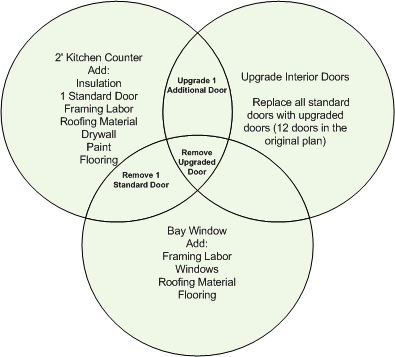Choice Intersections
Basic Intersection Model
In this section, we take a closer look at how Choice Intersections work by considering the following example:
We have three different Options available to a customer:
2’ Kitchen Cantilever
Upgrade Interior Doors
Bay Window
The diagram below shows the impact to takeoff items if these options are selected:

To clarify:
If the customer selects only the 2’ Kitchen Cantilever, we will need to add takeoff items for insulation, 1 standard door, framing labor, roofing material, drywall, paint, and flooring.
If the customer selects only the Upgraded Interior Doors, we will need to pull out the standard doors and replace them with the upgraded doors.
If the customer selects only the Bay Window, we will need to add framing labor, windows, roofing material, and flooring.
If the customer selects the 2’ Kitchen Cantilever AND the Upgraded Interior Doors, then the additional door that came in as a result of the Cantilever needs upgraded also.
If the customer selects the Bay Window AND the 2’ Kitchen Cantilever, we need to remove 1 standard door.
If the customer selects the 2’ Kitchen Cantilever, Upgraded Interior Doors AND the Bay Window, we need to remove one of the upgraded doors instead of removing one standard door.
Thus, in this example, we have three choices:
• 2’ Kitchen Cantilever
• Upgrade Interior Doors
• Bay Window
And three intersections:
2' Kitchen Cantilever and Upgraded Interior Doors
Bay Window and 2' Kitchen Cantilever
Bay Window, 2' Kitchen Cantilever and Upgraded Interior Doors
Note
Any time you have material that is needed ONLY if more than two different choices are selected, you have an intersection.
The need for an intersection is fairly obvious most of the time, but sometimes it can be a bit unclear. For example, Carpet Pad and Carpet can be considered an intersection, since you only want carpet pad in rooms that also have carpet. If you upgrade the room to Hardwood flooring, you would not only remove the carpet, you would also remove the carpet pad.